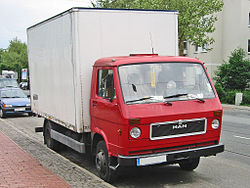MAN-VW
| MAN - VW | |
|---|---|
|
MAN-VW 6-10 ton truck
|
|
| G 90 | |
| Manufacturer: | MAN , VW |
| Production period: | 1979-1993 |
| Previous model: | MAN Saviem |
| Successor: | MAN L 2000, VW L80 |
| Technical specifications | |
| Designs: | Flatbed truck , tipper , tractor unit , chassis |
| Engines: |
Diesel engines : 3.8–6.6 liters |
| Power: | 66-114 kW |
| Length: | from 5405 mm |
| Width: | 2220-2366 mm |
| Height: | 2338-2410 mm |
| Wheelbase: | 3100-5100 mm |
The MAN-VW , originally as a 6-9 tonner , from 1981 to 1987 as a 6-10 tonner and from 1987 onwards as the G 90 , is a truck developed in cooperation between MAN and Volkswagen AG and produced from 1979 to 1993 .
history
After the cooperation between MAN and the French manufacturer Saviem came to an end in 1977, MAN looked for a new partner for the construction of light trucks and found one in Volkswagenwerk AG . On August 25, 1977, MAN and Volkswagen signed a cooperation agreement that included the joint development and production of light trucks.
After Magirus-Deutz had launched the first tilting cab in the light to medium weight class in Germany as part of the four-man club in which MAN originally wanted to participate, the cooperation model between MAN and VW should also have such a cab receive. MAN contributed the diesel engines, chassis and front axles, while the VW LT- derived driver's cab, gearbox and rear axles came from VW. In contrast to the partnership with Saviem, the front of the vehicles was provided with the logos of both companies.
The model appeared in 1979 with gross vehicle weights between 6 and 9 t, and from 1981 also 10 t, with a choice of two naturally aspirated diesel engines with 90 and 136 hp (66 and 100 kW). The vehicle was available as a flatbed truck , with a tipping bridge , as a tractor unit and as a chassis with a driver's cab .
Three quarters of the vehicles were to be produced in the VW plant in Hanover and a quarter in the MAN plant in Salzgitter- Watenstedt . However, since fewer vehicles could be sold than planned, the ratio shifted to around 50:50. In the last few years, production was only carried out in Salzgitter.
The only major revision was presented at the 1987 International Motor Show; the previously round headlights next to the radiator grille were replaced by square ones in the bumper. The displacement per cylinder was increased from 0.95 l to 1.15 l and the speed was reduced from 3000 to 2700 revolutions per minute. The engine output increased to 100 and 150 hp (74 and 110 kW). With a new interior, it was now positioned in the market as the "G 90", sometimes also referred to as the G series.
The cooperation between MAN and VW ended in 1993 after around 72,000 vehicles were produced.
As a successor, MAN developed the new type L 2000, which started at 7.49 t gross vehicle weight and had a cabin more similar to the design of its own heavy-duty truck, which came from the Austrian truck manufacturer Steyr , which had been taken over four years earlier .
As a successor, VW developed the L80 , which was manufactured by Volkswagen Caminhões e Ônibus in Brazil and offered from 1995. Even today, the vehicle is modernized in Brazil as VW Delivery and the VW Worker derived from it is produced.
Technical specifications
The model designation is made up of the gross vehicle weight, rounded up to whole tons , and the engine power in horsepower .
For example, the 6.90 model, which was offered as a flatbed truck and tipper, has a gross vehicle weight of 6 tons and an engine output of 90 hp. Other model names were 6.100, 8.90, 8.100, 8.136, 8.150, 9.136, 9.150, 10.136 and 10.150.
The following engines, among others, were available:
| model | Displacement | Bore × stroke | Motor series | power | |
|---|---|---|---|---|---|
| Inline four-cylinder : | |||||
| 8,090 | 3791 cc | 102 × 116 mm | MAN D0224 | 66 kW ( 90 PS) at 3000 rpm | |
| 8,100 | 4397 cc | 108 × 120 mm | MAN D0824 | 74 kW (100 PS) at 3000 rpm | |
| Inline six-cylinder : | |||||
| 8,136 | 5687 cc | 102 × 116 mm | MAN D0226 | 100 kW (136 hp) at 3000 rpm | |
| 8,150 | 6595 cc | 108 × 120 mm | MAN D0826 | 110 kW (150 PS) at 3000 rpm | |
The engines were always combined with a fully synchronized 5-speed manual transmission, the larger models were equipped with power steering as standard .
Optionally have included all-wheel drive , anti-lock brakes , double cabin , air suspension available and different axle ratios and wheel bases.
Application examples
Trivia
From 1979 to 1987 produced version MAN-VW 8.90 F flatbed , the company introduced Conrad models a miniature 1:50 scale model here. The Sieper GmbH had branded Siku from 1982/83 to 1991/92 toy cars of MAN-VW on offer.
Web links
Individual evidence
- ↑ Looking back: August 25, 1977 - 40 years ago today. In: Wolfsburger Nachrichten. Friday Packet for August 25, 2017.
- ↑ Lastauto Omnibus Catalog 1988 , Issue No. 17, Vereinigte Motorverlage GmbH & Co. KG, Stuttgart 1987, pp. 36–39, 172.
- ↑ The 8-ton variant is an example of all tonnages. See table: Lepper, Andreas. 2011. "MAN" Andy's Truckinfo . Sept. Online .












